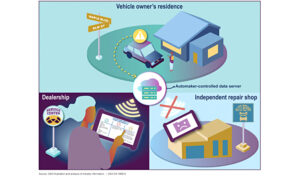The repair-age sweet-spot population will be down by nearly 15% in 2030, with fewer cars and light trucks 6-to-10 years old on U.S. roads
Fort Wayne, Ind.—New vehicle annual sales in the U.S. will fall by 15% from 2020 through 2024, according to a new report by Lang Marketing, which will send repercussions through the light vehicle aftermarket.
“Over the next 10 years, the significant downturn of the new vehicle market (2020 through 2024) will negatively impact the number of Internal Combustion Engine (ICE) vehicles in operation and shrink the size of the ICE aftermarket,” Lang states.
The following is a breakdown of the analysis and implications for the aftermarket in coming years.
12 Million Fewer Vehicles Sold
New car and light truck annual sales in the U.S. averaged 17.3 million between 2015 and 2019.
The new vehicle market in the U.S. fell abruptly in 2020 to 14.7 million, down from 17.0 million the previous year. Annual sales continued at low levels, with 14.9 million in 2021 and a further slide to 13.8 million cars and light trucks last year.
2023 Sales and Beyond
Lang Marketing projects that in 2023, new vehicle sales will fail to top 15 million. Next year, the new vehicle market will show some renewed strength, but 2024 annual sales will falter below 16 million. New car and light truck volume will total over 12 million fewer during 2020 through 2024 than if sales had continued at the 17.3 million annual average of the previous five years (2015 through 2019).
VIO Impact
The new vehicle shortfall between 2020 and 2024 will reduce the growth of vehicles in operation (VIO) through at least 2026. ICE vehicles will suffer most of the lost sales. This means that the population of ICE cars and light trucks on U.S. roads through this decade will be noticeably lower than had new vehicle annual volume remained at the 17.3 million level.
Peak ICE Vehicle Population
The year when the ICE VIO will peak will occur earlier than if the recent downturn in new vehicle volume had not occurred. Several years ago, Lang Marketing anticipated the occurrence of peak ICE after 2030. Under current circumstances, peak ICE will arrive several years earlier.
Aftermarket Impact
The downturn in new vehicle volume will be positive for aftermarket product sales in the short run. The average age of vehicles will climb, and the number of older cars and light trucks will reach historic-high levels. Accordingly, older cars and light trucks will travel more miles and their odometers will reach record levels.
These factors will boost aftermarket product sales through 2026. However, the ICE vehicle population will be lower than if new vehicle volume (dominated by ICE cars and light trucks) would have remained strong from 2020 through 2024.
Domestic Versus Foreign Nameplates
Foreign nameplate cars and light trucks account for high levels of new vehicle sales in the U.S. As a result, the foreign nameplate share of cars and light trucks on U.S. roads continues to increase, reducing the VIO share of domestic nameplates.
Foreign Nameplate Aftermarket
The foreign nameplate aftermarket will be boosted for years to come by the growth in the foreign nameplate share of new car and light truck sales, which experienced accelerated growth following the 2008 economic downturn and has continued at a high level since then, increasing the foreign nameplates’ VIO share.
Foreign nameplate aftermarket product volume will also be boosted by the disproportionate share of vehicle scrappage suffered by domestic nameplates, caused by their high percentage of older cars and light trucks.
Repair-Age Sweet-Spot
The sharp reduction in new vehicle volume is working its way through the VIO age mix to the repair-age sweet-spot (vehicles 6 to 10 years of age). At mid-year 2030, the repair-age sweet-spot population will be down by nearly 15%, with approximately 74 million cars and light trucks 6-to-10 years old on U.S. roads compared to over 86 million during 2023.
Aftermarket Consequences
The lower population of the 6-to-10-year repair-age sweet-spot will not directly reduce aftermarket volume since miles on U.S. roads will be shifted to older vehicles, which generate more aftermarket product volume per mile than younger models.
However, the dynamics causing the shrinkage of vehicles in this age group will affect ICE aftermarket product sales over time, since the reduced number of vehicles will be almost entirely the result of fewer ICE vehicles.
Overall Impact
Low new car and light truck annual sales between 2020 and 2024 (and, perhaps, beyond) will be positive for the ICE aftermarket in the short run. Still, it will reduce the ICE VIO in the long run and put downward pressure on the ICE aftermarket as the decade progresses.




Comments are closed.